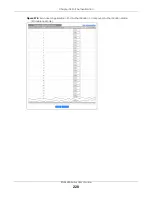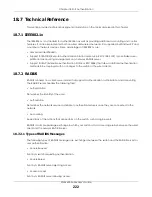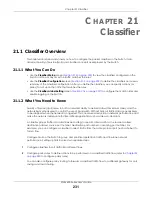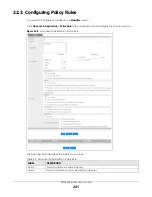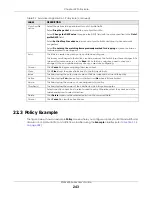
Chapter 21 Classifier
XGS4600 Series User’s Guide
231
C
HAPTER
21
Classifier
21.1 Classifier Overview
This chapter introduces and shows you how to configure the packet classifier on the Switch. It also
discusses Quality of Service (QoS) and classifier concepts as employed by the Switch.
21.1.1 What You Can Do
• Use the
Classifier
Status
screen (
) to view the classifiers configured on the
Switch and how many times the traffic matches the rules.
• Use the
Classifier
Configuration
screen (
) to define the classifiers and view a
summary of the classifier configuration. After you define the classifier, you can specify actions (or
policy) to act upon the traffic that matches the rules.
• Use the
Classifier
Global Setting
screen (
) to configure the match order and
enable logging on the Switch.
21.1.2 What You Need to Know
Quality of Service (QoS) refers to both a network's ability to deliver data with minimum delay, and the
networking methods used to control the use of bandwidth. Without QoS, all traffic data is equally likely
to be dropped when the network is congested. This can cause a reduction in network performance and
make the network inadequate for time-critical application such as video-on-demand.
A classifier groups traffic into data flows according to specific criteria such as the source address,
destination address, source port number, destination port number or incoming port number. For
example, you can configure a classifier to select traffic from the same protocol port (such as Telnet) to
form a flow.
Configure QoS on the Switch to group and prioritize application traffic and fine-tune network
performance. Setting up QoS involves two separate steps:
1
Configure classifiers to sort traffic into different flows.
2
Configure policy rules to define actions to be performed on a classified traffic flow (refer to
to configure policy rules).
You can also configure policy routing to forward a classified traffic flow to a different gateway for cost
savings and load sharing.
Содержание XGS4600 Series
Страница 24: ...24 PART I User s Guide ...
Страница 44: ...44 PART II Technical Reference ...
Страница 180: ...Chapter 13 Spanning Tree Protocol XGS4600 Series User s Guide 180 Figure 145 MSTP and Legacy RSTP Network Example ...
Страница 189: ...Chapter 16 Mirroring XGS4600 Series User s Guide 189 Figure 150 Advanced Application Mirroring Standalone Mode ...
Страница 244: ...Chapter 22 Policy Rule XGS4600 Series User s Guide 244 Figure 189 Policy Example EXAMPLE ...
Страница 277: ...Chapter 25 Multicast XGS4600 Series User s Guide 277 Figure 215 Advanced Application Multicast MVR Standalone Mode ...
Страница 559: ...Chapter 59 Access Control XGS4600 Series User s Guide 559 Figure 460 Example Lock Denoting a Secure Connection EXAMPLE ...
Страница 586: ...Chapter 69 Configure Clone XGS4600 Series User s Guide 586 Figure 479 Management Configure Clone Standalone Mode ...
Страница 587: ...Chapter 69 Configure Clone XGS4600 Series User s Guide 587 Figure 480 Management Configure Clone Stacking Mode ...
Страница 594: ...Chapter 71 Port Status XGS4600 Series User s Guide 594 Figure 485 Management Port Status Port Details Standalone Mode ...
Страница 604: ...604 PART III Troubleshooting and Appendices ...




